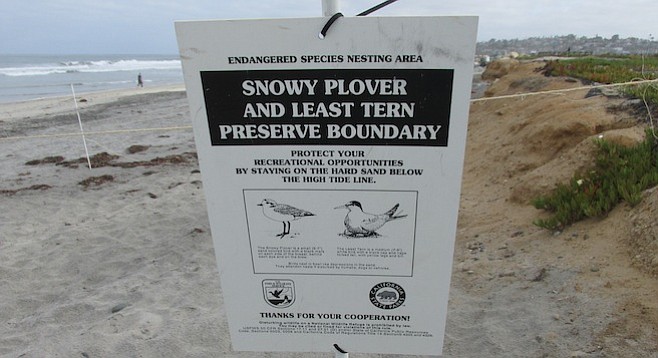 Facebook
Facebook
 X
X
 Instagram
Instagram
 TikTok
TikTok
 Youtube
Youtube

The western snowy plover must not be able to read. For the first time in years, the federally endangered bird has jumped across its well-signed and protected nesting areas in the San Elijo Lagoon, on the east side of Coast Highway 101, and, as of last week, is setting up home right on the beach.
As of May 8, one pair was already sitting on three eggs; another pair has been looking around for new digs. Darren Smith, a senior environmental scientist for California State Parks, says they have seen several “nest scrapes” — areas where the birds scratch the ground to find a potential home. And as many as five adults have been seen running along the shoreline.
“The fledglings like to forage for food along the water’s edge,” Smith said, “but this is the first time we’ve seen them nest on the beach.”
The nesting area, a small section of Cardiff State Beach, has been roped off and warning signs posted so people stay away. The agencies involved will not be erecting a more permanent fence, as they have in other plover nesting areas.
“We want to keep predatory birds from being able to perch,” said Robin Greene, state parks superintendent of the San Diego Coast District's North Sector. Also of concern: it’s a popular beach for dogs.
The bird’s nesting area near Seaside Beach has been slated for restoration of “living dunes” — a project to return sections of the beach back to what it used to look like before the railroad, freeway, and upstream dams blocked the natural flow of water and sand.
The City of Encinitas is also looking at the return of the dunes as a way to protect Coast Highway, which for decades has faced erosion due to lack of sand replenishment.
“We’ve moved some sand around — maybe that’s what the birds liked,” said Greene. "They didn’t seem to care we weren’t finished yet.”
“We don’t know yet if this will be a viable nesting site,” said Smith. The U.S. Fish and Wildlife Service will ultimately decide if the small strip of sand, butted up against cobblestone rocks and sandstone berm of Coast Highway, will become a preserve.
Smith predicted the ropes and signs would be removed at the end of nesting season, around mid-September.


The western snowy plover must not be able to read. For the first time in years, the federally endangered bird has jumped across its well-signed and protected nesting areas in the San Elijo Lagoon, on the east side of Coast Highway 101, and, as of last week, is setting up home right on the beach.
As of May 8, one pair was already sitting on three eggs; another pair has been looking around for new digs. Darren Smith, a senior environmental scientist for California State Parks, says they have seen several “nest scrapes” — areas where the birds scratch the ground to find a potential home. And as many as five adults have been seen running along the shoreline.
“The fledglings like to forage for food along the water’s edge,” Smith said, “but this is the first time we’ve seen them nest on the beach.”
The nesting area, a small section of Cardiff State Beach, has been roped off and warning signs posted so people stay away. The agencies involved will not be erecting a more permanent fence, as they have in other plover nesting areas.
“We want to keep predatory birds from being able to perch,” said Robin Greene, state parks superintendent of the San Diego Coast District's North Sector. Also of concern: it’s a popular beach for dogs.
The bird’s nesting area near Seaside Beach has been slated for restoration of “living dunes” — a project to return sections of the beach back to what it used to look like before the railroad, freeway, and upstream dams blocked the natural flow of water and sand.
The City of Encinitas is also looking at the return of the dunes as a way to protect Coast Highway, which for decades has faced erosion due to lack of sand replenishment.
“We’ve moved some sand around — maybe that’s what the birds liked,” said Greene. "They didn’t seem to care we weren’t finished yet.”
“We don’t know yet if this will be a viable nesting site,” said Smith. The U.S. Fish and Wildlife Service will ultimately decide if the small strip of sand, butted up against cobblestone rocks and sandstone berm of Coast Highway, will become a preserve.
Smith predicted the ropes and signs would be removed at the end of nesting season, around mid-September.
Comments